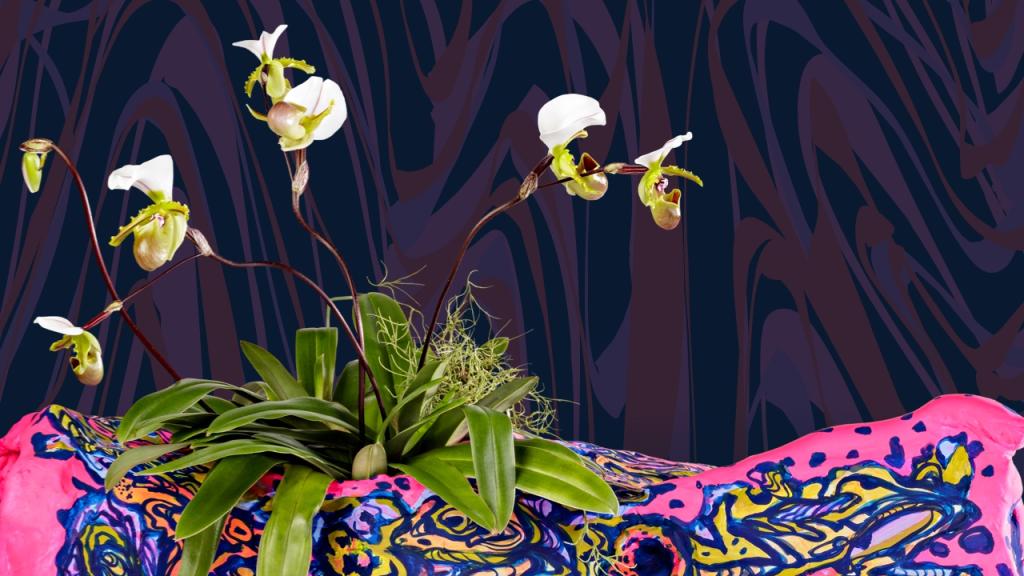Smithsonian Gardens and the United States Botanic Garden will present “The Future of Orchids: Conservation and Collaboration” from Jan. 27 through April 28, filling the entire Kogod Courtyard of the Smithsonian American Art Museum and National Portrait Gallery with around 350 live orchids. The display will feature a series of newly commissioned and loaned works by contemporary multimedia artist, Phaan Howng, to help audiences visualize the future of orchids and be inspired to take action toward a sustainable future.
Centered around the themes of the future of orchids and orchid conservation, the exhibition will explore the numerous challenges facing wild orchids today, including climate change, habitat destruction and over-collecting, and offer a glimpse into the work being performed today by a diverse group of scientists and conservationists to protect the future of orchids. The exhibition will inspire visitors to take action to support orchid conservation and introduce young visitors to career opportunities in conservation.
“‘The Future of Orchids’ is a rare and spectacular opportunity to take a deep dive into the weird and wild world of orchids,” said Joy Columbus, director of Smithsonian Gardens. “The exhibit celebrates the diversity of orchids, which, with an estimated 30,000 species, is one of the largest and most diverse families in the plant kingdom. With this immersive exhibit, visitors can check out their bright colors, showy patterns and unexpected forms, and maybe catch a smell of their wildly varying aromas too.”
The 2024 orchid exhibit will feature artworks by Howng, who is known for her large-scale paintings and immersive installations that explore the complex relationships between humans and nature. Baltimore-based Howng will present a series of newly commissioned paintings and sculptures, titled “The Orchids’ Fungi Garden Paradise,” which includes her “Mountains” series. She drew inspiration for her work from Smithsonian Gardens’ vibrant Orchid Collection. Howng adapted 3D scans of orchids created by the Smithsonian Digitization Program Office, which specializes in advanced 3D imaging of the Smithsonian’s collections. Sculptures inspired by these 3D digital renderings will be showcased alongside hundreds of colorful orchids from the Smithsonian and U.S. Botanic Garden’s living collections.
“It is a joy to continue this collaboration to spotlight the beauty of orchids, the challenges they face and the opportunities we have to save them,” said Susan Pell, executive director of the U.S. Botanic Garden. “Both of our institutions help conserve rare and endangered orchids through our international collections stewardship and our collaboration on the North American Orchid Conservation Center."
This orchid exhibition is the 28th annual collaboration between Smithsonian Gardens and the U.S. Botanic Garden. The annual exhibition was established to provide the public with the opportunity to learn about both institutions’ rich and biodiverse orchid collections. Public garden plant collections, like those managed by Smithsonian Gardens and the U.S. Botanic Garden, are vital conservation resources, offering species protection from habitat loss.
# # #
About Smithsonian Gardens
In 1972, former Smithsonian Secretary S. Dillon Ripley established Smithsonian Gardens to extend the Institution’s exhibition, research and education efforts through horticulture. Today, Smithsonian Gardens continues that founding legacy as an accredited museum and center for horticulture, education and research. Our exterior and interior gardens, exhibitions, collections and programs engage, inform and inspire 26 million visitors annually. The Smithsonian Gardens Orchid Collection, which was started in 1976, contains more than 5,000 species and hybrids. Visit gardens.si.edu to learn more.
About U.S. Botanic Garden
The United States Botanic Garden (USBG) is the oldest continuously operating public garden in the United States, established by Congress in 1820. The U.S. Botanic Garden inspires people to appreciate, study and conserve plants to enrich society locally and globally. With over a million visitors annually, the USBG strives to demonstrate and promote sustainable practices. It is a living plant museum accredited by the American Alliance of Museums and Botanic Gardens Conservation International. www.USBG.gov
